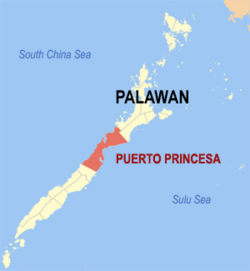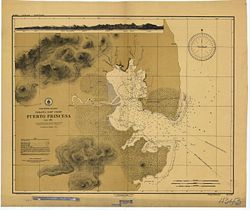Puerto Princesa City
| Location | |
 |
|
| Government | |
| Region | MIMAROPA (Region IV-B) |
|---|---|
| Province | Palawan |
| District | 2nd district of Palawan |
| Barangays | 66 |
| Income class: | 1st class city; highly urbanized |
| Mayor | Edward S. Hagedorn (Lakas-CMD) |
| Cityhood | June 21, 1961 |
| Physical characteristics | |
| Area | 2,400 km² |
| Population | |
| Total (2007) | 210,508 |
| Density | 67/km² |
The City of Puerto Princesa (Filipino: Lungsod ng Puerto Princesa), the capital of Palawan, is a first class city in the Philippines. According to the 2007 census, it has a population of 210,508 people in 33,306 households. It is famous for its crocodile farms, underground rivers and dive spots. It is also the largest city in the Philippines in terms of total land area. This city is the hometown of the former House Speaker Ramon Mitra, Jr..

The Puerto Princesa Subterranean River National Park, a UNESCO World Heritage Site, features a spectacular limestone karst landscape with its underground river. A distinguishing feature of the river is that it flows directly into the sea, and the lower portion of the river is subject to tidal influences. The area also represents a significant habitat for biodiversity conservation. The site contains a full mountain to the sea ecosystem and protects forests, which are among the most significant in Asia.
On June 30, 1992, Edward S. Hagedorn was elected Mayor of the city and completed his three term limit of three years for every term. In November 2002, Hagedorn was re-elected as mayor of the city.
Although a highly-urbanized city, its charter permits its voters to vote for provincial positions but not does not allow them to run for these positions.[1]
Contents |
Geography
Puerto Princesa City lies at the mid-section of the long strip of Palawan Island province. It is approximately 306 nautical miles from Manila, 206 nautical miles to Panay Island and about 250 nautical miles to Zamboanga. It is bounded on the North by the Municipality of San Vicente and Roxas and on the South by the Municipality of Aborlan. Its Western side is a coastline of the South China Sea while to the East lies the Sulu Sea.
Total land area is 253,982 hectares stretched over 106 kilometers long with the narrowest breadth of 8.5 kilometers in Barangay Bahile.
Puerto Princesa City has now 35 urban barangays and 31 rural or a total of 66 barangays.
History
Legend attributes the name “Puerto Princesa” to a princess-like maiden who in the early days is said to have roamed around the place on certain nights of the year. On the other hand, practical people attribute the name to the geographical advantages of the place as a seaport – naturally protected the whole year round and endowed with a depth that can accommodate any size of shipping – a royal heaven for vessels or a virtual princess of ports as thus indicated by Spanish Colonizers on the country’s map.
Historically, the place was named after Princess Eulalia of Spain, born in 1864 to Queen Isabel II and her consort, Dr. Francisco de Asis. When the princess suffered an untimely death, the Queen changed the name to Puerto de la Princesa. Eventually, the name was reduced to Puerto Princesa as it is known today.
Spanish Colonizers founded the settlement on March 4, 1872 in the course of their exploration of the province. As they scanned the Palawan shoreline for a capital site, they came upon a hill with steep declivity. Rowing to shore, they surveyed the hill and discovered an extensive plateau which they decided as ideal for settlement.
Soon after, Fr. Antonio Muro levelled a portion of the hill to make way for a chapel. (That section is now occupied by the Catholic Cathedral, the P.C. Barracks and the Rizal Park. The Old Municipal Building used to be there, as well as an Elementary School). The first mass celebrated in Puerto Princesa took place at a site where a marker now stands.
In May 1872, the port became the center of Spanish Naval Operations in the area because the few natives were peaceful and the Bay met all the Navy’s requirements. Royal Decrees later provided incentives to settlers, such that by 1883 settlement had flourished into a town of twelve roads, a hospital and well built port.
In 1894, Puerto Princesa was recognized by government authorities as one of the most beautiful towns in the country by virtue of the orderly distribution of streets, buildings and houses as well as the cleanliness of the community.
In 1911, the New American Administration made Puerto Princesa the seat of the Palawan Provincial Government with Major John Brown as Lieutenant Governor.
The town was converted into a city on January 1, 1970 under R.A. 5906 as amended by P.D. 437, through the effort of then Congressman Ramon V. Mitra, Jr. Feliberto R. Oliveros, Jr. became the first City Mayor.
Since its foundation, Puerto Princesa has been the nerve center of activities in Palawan. Aside from being the seat of public administration, it is the heart of trade, commerce, service, and industry in the province.
Today, under the leadership of Mayor Edward S. Hagedorn, the City has gained the distinction of being a model city – in cleanliness, environmental protection and conservation, and local governance in general.
And so, with a responsive leadership and an inspired citizenry, the tradition of Puerto Princesa being a beautiful and clean city lives on.
People/Culture
Waves of migrants from other Philippine provinces, and even other countries, have turned Puerto Princesa into a melting pot of various cultures. Among the original inhabitants are the Cuyunons who have a rich legacy of folklore and traditions. Indigenous groups include the Tagbanuas and the Bataks, each group with its distinct culture and system of beliefs.
Total inhabitants number about 161,912 (as of May, 2000), Three fourth of the population resides in the city proper, an urban settlement on the shores of Puerto Princesa Bay. While the predominant local tongue is Cuyuno, Tagalog, Visayan, as well as English are widely spoken.
E-tricycle
Puerto Princesa Mayor Edward S. Hagedorn unveiled the environment-friendly and economical electric-powered “Trikebayan” (which does not emit any noise or carbon monoxide) at the Kapihan sa Sulo forum, Sulo Hotel, Quezon City. The Trikebayan costs only P 48 or $ 1.20 per day to operate, while a gasoline-powered tricycle operation would cost P 200. Rolly Concepcion, who conceptualized the Trikebayan, said that converting a tricycle engine to electric costs P 68,000. The 36-watt rechargeable battery under the passenger seat can run for 12 hours.[2]
Major awards of Puerto Princesa
Earth Day Award, 1993
“Hoy! Gising” Award, 1993
Best Local Government Unit Award, 1994
Macli-ing Dulag Environmental Achievement Award, 1994
Gantimpalang Panglingkod (GALING-POOK) Award for Bantay Puerto Program, 1994
Award of Excellence: Cleanest and Greenest Component City of the Philippines, 1994
Best Tourist Destination, 1994
Peace Award, 1995
Commerce and Conscience Award, 1995
Cleanest Inland Body of Water, Region IV, 1995
Nutrition Green Banner Award, 1995
Award of Excellence: Cleanest and Greenest Component City of the Philippines, 1995
Most Outstanding Performer of the Year, 1996
Best City Police Station, 1996
Best Local Government Unit, 1996
Management Awards of Asia (for Development Management), 1996
Gawad Pamana ng Lahi (Heritage Award), 1996
Likas-Yaman Awards for Environmental Excellence, 1996
Gantimpalang Panglingkod (GALING-POOK) Awards (1996) for: The Oplan Linis Program; The City Satellite Hospitals; and The City Satellite Libraries
Most Active Proponent of Coastal Clean-up, 1996
Hall of Fame Award (Regional Clean and Green), 1996
Award of Execellence: Cleanest and Greenest Component City of the Philippines, 1996
Global 500 Roll of Honour Award (United Nations Environment Programme), 1997
Gantimpalang Panglingkod (GALING-POOK) Award for Carabao and Tractor Pool, 1997
Hall of Fame Award (Asian Institute of Management), 1997
Barangays
Puerto Princesa City is politically subdivided into 66 barangays, 35 in urban area and 31 in rural area.
|
|
|
Television Networks
- AZ Communications: Channel 2
- National Broadcasting Network: Channel 4
- Conamor Broadcasting System: Channel 5
- Palawan Broadcasting Corporation: Channel 7
- GMA Network: Channel 12
- Intercontinental Broadcasting Corporation: Channel 13
- ABS-CBN: Channel 23
- ACQ-Kingdom Broadcasting Network: Channel 35
External links
|
||||||||
|
|||||||||||
|
|||||||||||